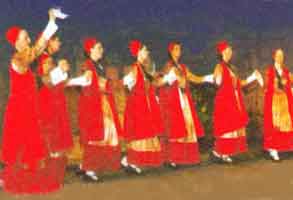.
The Kalamatianós Dance is one of the best known dances of Greece. It is popular Greek folkdance throughout Greece, Cyprus and internationally and is often performed at many social gatherings worldwide. As is the case with most Greek folk dances, it is danced in circle with a counterclockwise rotation, the dancers holding hands. It is a joyous and festive dance; its musical beat is 7/8, subdivided into two sets of 3 and 4 beats. The steps are 12: 10 steps counterclockwise ("forward") followed by 2 steps clockwise ("backwards"). Depending on the occasion and the dancers' proficiency, certain steps may be taken as jumps or squats. The lead dancer usually holds the second dancer by a handkerchief, this allowing him or her to perform more elaborate steps and acrobatics. The steps of the Kalamatianós are the same as those of the Syrtos, but the latter is slower and more stately, its beat being an even 4/4.

Kalamatianos Dance
History
The roots of Kalamatianos can be found in antiquity. Homer, in the Illiad, describes three performances made around the spear of Achilles that depict a dance in an open circle. The ancient Spartans had a dance called ormos, which was a syrto style dance described in detail by Xenophon where a woman led a male into dance using a handkerchief. Lucian states that the ormos dance was performed in an open circle and was done by young men and women. The men would dance vigorously while the women danced with modest movements.[1] In the 19th century, this dance was called Syrtos O Peloponisios. It is believed to have acquired the name kalamatianos from the town of Kalamata in southern Greece; most Greek dances are commonly named after the villages or areas from which they are considered to have originated.[2] Kalamatiano songs are many and popular - some of the more traditional kalamatiano songs are Samiotissa (The girl from Samos), Mandili Kalamatiano (Kerchief from Kalamata), Milo Mou Kokkino (My Red Apple), To Papaki (The Duckling), Mou Pariggile To Aidoni (The Nightingale sent me a message), Ola Ta Poulakia (All Birds), etc. An especially haunting example of the kalamatianos, Mekapses Yitonissa (Μέκαψες Γειτόνισσα), was recorded for the National Geographic Society's groundbreaking Music of Greece album, released in 1968.
Contemporary influence
The American jazz composer, Dave Brubeck, well known for his exploration of asymmetrical rhythms in his own music, used a variant of the rhythm of the Kalamatianos for his Unsquare Dance, though the measures are divided into two groups of 4 followed by 3 beats rather than 3 followed by 4. The 1960s popular singer, formerly known as Cat Stevens, wrote and performed a song, Ruby Love, in 7/8 time with a distinctive Greek flavour. Stevens, who would later convert to Islam, has paternal Greek Cypriot roots. Near the end of the 2002 film, My Big Fat Greek Wedding, the cast dances the kalamatianos to the song, Orea Pou Ine I Nifi Mas (Ωραία που είναι η νύφη μας) at Ian and Toulla's wedding reception.
Song lyrics
Milo Mou Kokkino a traditional kalamatiano song from Western Macedonia.[3]
Lyrics
Μήλο μου κόκκινο, ρόιδο βαμμένο (x2)
Γιατί με μάρανες το πικραμένο 1
Παένω κ’ έρχομαι μα δεν βρίσκω (x2)
Βρίσκω την πόρτα σου μανταλομένη 1
Τα παραθυρούδια σου φεγγοβολούνε (x2)
Ρωτάω την πόρτα σου, που πάει η κυρά σου 1
Κυρά μ’ δεν είναι ‘δώ, πάησε στην βρύση (x2)
Πάησε να βρει νερό και να γεμίσει 1
Translation
My red apple, my scarlet pomegranate,
why have you made me wilted and bitter?
I come and go, but cannot find you
I try your door, and it's always locked.
Your windows are always lighted
I ask your door, "Where is your lady?"
"My lady is not here, she is at the wellspring
She's gone to bring water".
References
^ Lykesas, p. 122.
^ Lykesas, p. 123.
^ Boston Lykeion Ellinidon - Milo Mou Kokkino
Sources
George H. Lykesas [Γιώργος Χ. Λυκέσας]. Οι Ελληνικοί Χοροί [Greek Dances]. Thessaloniki: University Studio Press, 2nd Edition, 1993.
See also
Music of Greece
Kalamatianó music
Greek dances
Greek folk music
Tsamiko
Pentozali
Syrtos
Nisiotika
Ballos
Sousta
Ikariotikos
| Ancient Greece
Science, Technology , Medicine , Warfare, , Biographies , Life , Cities/Places/Maps , Arts , Literature , Philosophy ,Olympics, Mythology , History , Images Medieval Greece / Byzantine Empire Science, Technology, Arts, , Warfare , Literature, Biographies, Icons, History Modern Greece Cities, Islands, Regions, Fauna/Flora ,Biographies , History , Warfare, Science/Technology, Literature, Music , Arts , Film/Actors , Sport , Fashion --- |
Retrieved from "http://en.wikipedia.org/"
All text is available under the terms of the GNU Free Documentation License

